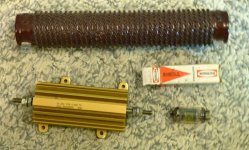Hello all. First, thank you for all the great help and info shared in this forum. I would not have been able to take on my SSE project without you!
So, my question is:
Can I simply bolt two of these to a heatsink with thermal paste and use it as a dummy load for my SSE?
HS25 8R F ARCOL / Ohmite | Mouser
Thanks!
David
So, my question is:
Can I simply bolt two of these to a heatsink with thermal paste and use it as a dummy load for my SSE?
HS25 8R F ARCOL / Ohmite | Mouser
Thanks!
David
Yes, that'll work. I use these in 8 ohms and 4 ohms versions.
8 Ohm 100W Non-Inductive Dummy Load Resistor
8 Ohm 100W Non-Inductive Dummy Load Resistor
Thank you!
My only pair of speakers right now are my prized Fostex FE108Sigmas that were discontinued long ago (and a pair of radio shack 40-1197's still in the boxes that are also oop).
I'd hate to damage them. These are great drivers for low power set amps when installed in horns like my Buschhorn MKII's.
David
My only pair of speakers right now are my prized Fostex FE108Sigmas that were discontinued long ago (and a pair of radio shack 40-1197's still in the boxes that are also oop).
I'd hate to damage them. These are great drivers for low power set amps when installed in horns like my Buschhorn MKII's.
David
The only problem with the Ohmites you listed is they are somewhat inductive just like any other standard wire wound resistor. If you look at the data sheet, it lists a "lower" inductive series, the NHS series. However, the resistor Pano listed is non-inductive and makes a great dummy load. I've always had good luck ordering from Parts Express.
Ken
Ken
they will laugh at 1000 watts.....you do not need a heat sink, just drop it in jar of water
I have been known to use a hair blow dryer.....Bob Carver lit up a toaster with one of his big amps. Whatever you use make sure it can't be switched off, or thermally shut down.....I set an OPT on fire when my Radio Shack resistor in a coffee cup full of water went open circuit. Yes I passed 150 watts through a 20 watt resistor. It did not like it.
Mine are only good to 500 watts (the big brown resistors).....or so they say. I have only fed them 525 watts of tube amp power so far.
The gold ones are good for 120 watts but I have fed them 160 watts without issue.
What is the issue with the dummy load being inductive?
I was reminded by a knowledgeable tube amp designer that those big brown resistors are inductive when they were shown in testing a 200 watt SE tube amp. Inductance in a resistor, or anything for that matter will make it's effective impedance higher than it's rated resistance at higher frequencies. This is a big deal in RF amps since a little inductance can turn into a big impedance rather quickly, but how much does it matter in audio?
This prompted me to make some measurements. I don't remember the exact numbers since it happened about 10 years ago, but the inductance of the big brown resistors was so low that it would amount to less than a 1% error in measurement at 20 KHz. Now the big brownies are made from a few turns of fat resistive ribbon spaced out over a long ceramic core so their inductance was quite low. A smaller resistor may have more turns of thinner wire, wound closer together, so they could contribute to a higher error at 20 KHz, but I doubt it's too big a deal. Probably a few % rather than a few dB.
A non inductive wirewound resistor is still made of wire wound on a form. It's just wound with half the turns in one direction, then the other half in the other direction so the inductance cancels itself out.
Attachments
Last edited:
For my dummy load, I calculated the length of enamelled copper wire (heavy gauge) to give me 2, 4 and 8 ohms. I then wrapped it around a simple wooden former made of 38mm square timber, with tappings at the 2 and 4 ohm points.
The resultant "contraption" was mounted on the workshop wall above the bench.
Largest amp tested was an FPC10000; the dummy load was only slightly warm, but very clearly audible. As a bonus, if you want to monitor the signal waveform, just lean the probe on the wooden frame.
Kevin
The resultant "contraption" was mounted on the workshop wall above the bench.
Largest amp tested was an FPC10000; the dummy load was only slightly warm, but very clearly audible. As a bonus, if you want to monitor the signal waveform, just lean the probe on the wooden frame.
Kevin
- Status
- This old topic is closed. If you want to reopen this topic, contact a moderator using the "Report Post" button.
- Home
- More Vendors...
- Tubelab
- Cheap 8 ohm dummy load for SSE
